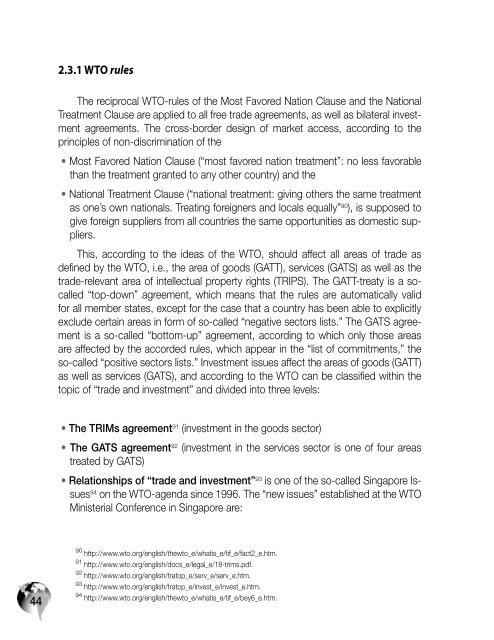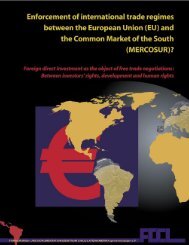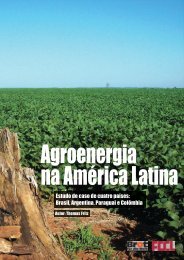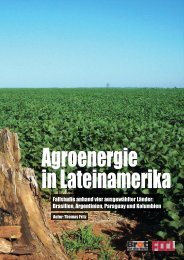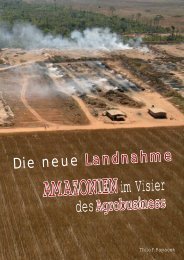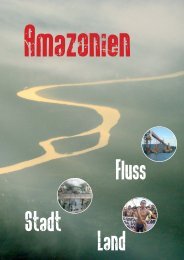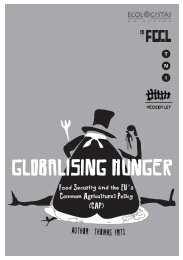(EU) and the Common Market of the South (MERCOSUR)? - FDCL
(EU) and the Common Market of the South (MERCOSUR)? - FDCL
(EU) and the Common Market of the South (MERCOSUR)? - FDCL
You also want an ePaper? Increase the reach of your titles
YUMPU automatically turns print PDFs into web optimized ePapers that Google loves.
44<br />
2.3.1 WTO rules<br />
The reciprocal WTO-rules <strong>of</strong> <strong>the</strong> Most Favored Nation Clause <strong>and</strong> <strong>the</strong> National<br />
Treatment Clause are applied to all free trade agreements, as well as bilateral investment<br />
agreements. The cross-border design <strong>of</strong> market access, according to <strong>the</strong><br />
principles <strong>of</strong> non-discrimination <strong>of</strong> <strong>the</strong><br />
• Most Favored Nation Clause (“most favored nation treatment”: no less favorable<br />
than <strong>the</strong> treatment granted to any o<strong>the</strong>r country) <strong>and</strong> <strong>the</strong><br />
• National Treatment Clause (“national treatment: giving o<strong>the</strong>rs <strong>the</strong> same treatment<br />
as one’s own nationals. Treating foreigners <strong>and</strong> locals equally” 90 ), is supposed to<br />
give foreign suppliers from all countries <strong>the</strong> same opportunities as domestic suppliers.<br />
This, according to <strong>the</strong> ideas <strong>of</strong> <strong>the</strong> WTO, should affect all areas <strong>of</strong> trade as<br />
defined by <strong>the</strong> WTO, i.e., <strong>the</strong> area <strong>of</strong> goods (GATT), services (GATS) as well as <strong>the</strong><br />
trade-relevant area <strong>of</strong> intellectual property rights (TRIPS). The GATT-treaty is a socalled<br />
“top-down” agreement, which means that <strong>the</strong> rules are automatically valid<br />
for all member states, except for <strong>the</strong> case that a country has been able to explicitly<br />
exclude certain areas in form <strong>of</strong> so-called “negative sectors lists.” The GATS agreement<br />
is a so-called “bottom-up” agreement, according to which only those areas<br />
are affected by <strong>the</strong> accorded rules, which appear in <strong>the</strong> “list <strong>of</strong> commitments,” <strong>the</strong><br />
so-called “positive sectors lists.” Investment issues affect <strong>the</strong> areas <strong>of</strong> goods (GATT)<br />
as well as services (GATS), <strong>and</strong> according to <strong>the</strong> WTO can be classified within <strong>the</strong><br />
topic <strong>of</strong> “trade <strong>and</strong> investment” <strong>and</strong> divided into three levels:<br />
• The TRIMs agreement 91 (investment in <strong>the</strong> goods sector)<br />
• The GATS agreement 92 (investment in <strong>the</strong> services sector is one <strong>of</strong> four areas<br />
treated by GATS)<br />
• Relationships <strong>of</strong> “trade <strong>and</strong> investment” 93 is one <strong>of</strong> <strong>the</strong> so-called Singapore Issues<br />
94 on <strong>the</strong> WTO-agenda since 1996. The “new issues” established at <strong>the</strong> WTO<br />
Ministerial Conference in Singapore are:<br />
90<br />
http://www.wto.org/english/<strong>the</strong>wto_e/whatis_e/tif_e/fact2_e.htm.<br />
91<br />
http://www.wto.org/english/docs_e/legal_e/18-trims.pdf.<br />
92<br />
http://www.wto.org/english/tratop_e/serv_e/serv_e.htm.<br />
93<br />
http://www.wto.org/english/tratop_e/invest_e/invest_e.htm.<br />
94<br />
http://www.wto.org/english/<strong>the</strong>wto_e/whatis_e/tif_e/bey6_e.htm.


